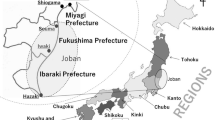Abstract
Many negative influences from the Great East Japan Earthquake of 2011, the subsequent tsunami, and Fukushima disaster, persist in the devastated areas, including reputational damage to the Japanese fishers. The Sanriku brand of wakame seaweed has experienced irrational reputational damage even though almost all of their products have tested negative for radioactivity. To recover from such damage, we tested the effectiveness of countermeasure promotions by measuring the effects of displayed elements on packaging and at a point of purchase (POP) display. Direct counter-promotion, such as mentioning radioactivity levels in seafood, can potentially cause adverse effects by reminding consumers of the radioactive contamination. Accordingly, we analyzed the direct effects of information about radioactive safety and the indirect effects of the information using images of a girl, aquaculture farmers, and a cook and labels of safety and security, inspection, and recovery from the earthquake disaster to identify which elements effectively mitigate irrational reputational damage. We employed conjoint analysis through a web survey. The results indicate that images and labels increase consumer utility without adverse effects. Furthermore, the labels of safety and security and inspection substitute the direct effect of publicizing the radioactivity test results.

Similar content being viewed by others
References
Morita A (2015) Recovery from earthquake-stricken farmland and nuclear accident. Rep Nippon Agric Res Inst 28:257–268 (in Japanese)
Suzuki H (2013) “Make an exit!” Challenges toward co-prosperity by producers and distributors: practical method of extensive distribution for low-used resources and unutilized resources. Nippon Suisan Gakkaishi 79(1):98–99 (in Japanese)
Shimizu M (2010) The possibilities and challenges for retailers handling regional brands: focusing on the Osakamon brand vegetables. J Rural Probl 45(4):336–342 (in Japanese with English abstract)
Kiyono S (2009) Effects by information statement marketing to consumers in a store. In: Umemoto M (ed) Distinction of behavior buying a fruit and marketing in store. Nourintokeipub, Tokyo, pp 97–112 (in Japanese)
Miyata T (2010) Basic issues in brand strategy for marine products. In: Lou X et al (eds) Logic and practice for branding marine products. Hokutopub, Tokyo, pp 281–302 (in Japanese)
Ito M, Suzuki M (2005) A study on the confidence and evaluation of the quality guarantee label on agricultural products. J Agric Sci (Tokyo Univ. of Agric.) 50(1):21–30 (in Japanese with English abstract)
Oishi T, Ominami J, Tamura N, Yagi N (2010) Estimates of the potential demand of Japanese consumers for eco-labeled seafood products. Nippon Suisan Gakkaishi 76(1):26–33 (in Japanese with English abstract)
Ariji M, Matsui T (2012) Grasp of consumer needs and merchandizing strategy for changing fisheries into 6th industry: the case of Miyazu City, Kyoto. J Int Fish 11:1–11 (in Japanese with English abstract)
Fujii Y, Umemoto M, Ooura U, Yamamoto J (2008) Distinction of buying behavior and tool of point-of-purchase marketing in direct selling shop for agricultural products. J Rural Probl 44(1):163–168 (in Japanese)
Miyata T, Wakamatsu H (2015) Irrational reputational damage on wakame seaweed in Sanriku district after the Fukushima nuclear disaster: revealed preference by auction experiment. Fish Sci 81(5):995–1002
Miyata T, Lou X, Onodera M (2008) Analysis of the competitive power of domestic seafood in a globalization Japanese market: a case of Japanese Wakame. J Reg Fish 48(1–2):1–17 (in Japanese with English abstract)
Ariji M (2011) A quantitative analysis for regional differences of tuna consumption preference. J Int Fish 10:27–41 (in Japanese with English abstract)
Acknowledgments
This study is funded mainly by the Agriculture, Forestry and Fisheries Council as part of the “Development research of sustainable production system in fisheries and aquacultures” project. The pictures were used with approval from the Iwate Prefecture Commerce and Marketing Division and Fisheries Promotion Division. We are grateful for the cooperation of these organizations.
Author information
Authors and Affiliations
Corresponding author
Rights and permissions
About this article
Cite this article
Miyata, T., Wakamatsu, H. Mitigating irrational reputational damage to marine products from radiation contamination. Fish Sci 82, 983–989 (2016). https://doi.org/10.1007/s12562-016-1024-6
Received:
Accepted:
Published:
Issue Date:
DOI: https://doi.org/10.1007/s12562-016-1024-6




